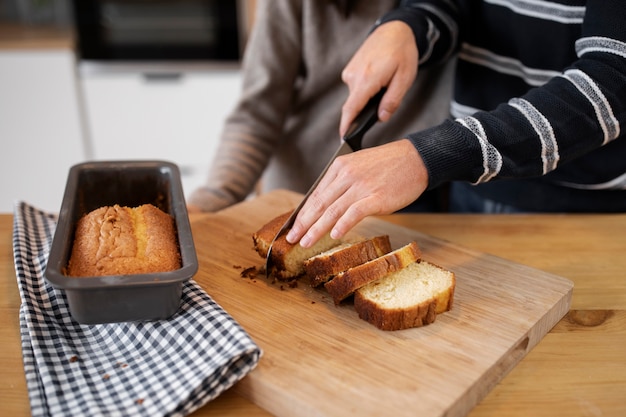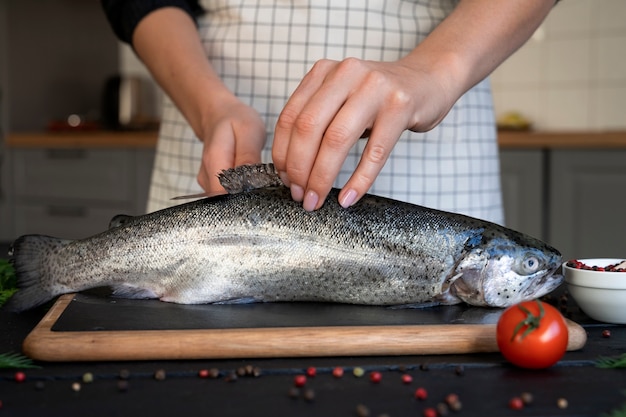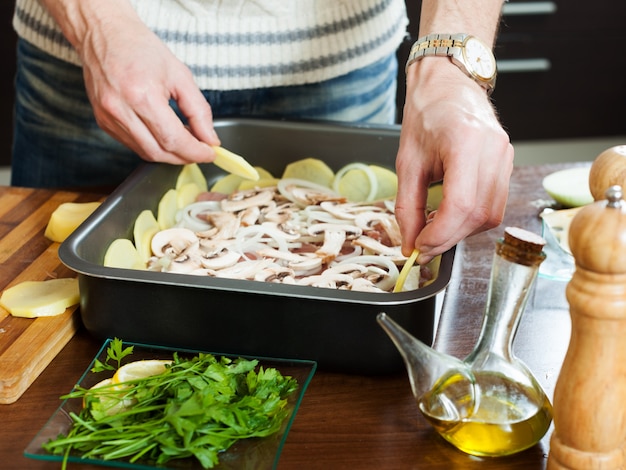Let's talk fish, but not just any fish. I'm talking about the kind that graces your dinner table, beautifully baked to flaky perfection. Baking fish is a simple yet rewarding culinary skill, and one I've been honing for years (with varying degrees of success, I must admit).
Baking fish can be a bit of a dance. It can go from beautifully flaky and moist to dry and overcooked faster than you can say "fish fingers." But fear not, fellow fish fanatics! I'm ready to share all the secrets I've picked up along the way. This guide is your ultimate cheat sheet, packed with tips, tricks, and recipes to make you a fish baking pro.
(Part 1) Choosing the Right Fish - It's All About the Catch

The first step in this culinary adventure is picking your fish. It's the foundation of your dish, so choosing wisely is crucial.
The Fishy Lineup: My Personal Picks
There's a whole world of fish out there, each with its own distinct personality and flavor profile. Here are some of my favorites for baking:
- Salmon: The king of baked fish, salmon is a real crowd-pleaser. It's rich and buttery, with a beautiful pink hue that just screams "delicious." Plus, it holds its moisture well during baking, making it a reliable choice for even novice cooks.
- Cod: This mild-mannered fish is a classic for a reason. It flakes beautifully and absorbs flavors readily, making it a perfect canvas for your culinary creations.
- Haddock: A close cousin to cod, haddock offers a slightly firmer texture and a touch of sweetness. It's another excellent option for a simple, flavorful bake.
- Sea Bass: If you're looking for a touch of elegance, sea bass is the way to go. It has a delicate flavor and cooks up beautifully with a crispy skin, making it ideal for special occasions.
- Trout: This is the rustic option, offering a slightly earthy flavor and quick cooking time. It's perfect for those who prefer a more down-to-earth meal.
But don't feel limited by these suggestions! There's a whole world of fish waiting to be discovered. Experiment with halibut, snapper, swordfish, or any other fish that catches your eye. You might just find your new favorite!
(Part 2) Preparing Your Fish: The Art of the Clean-Up

Once you've chosen your fish, it's time to prep it for its oven debut. This might sound intimidating, but it's actually quite simple, with a little guidance.
Gutting and Cleaning: A Fishy Anatomy Lesson
If you're working with a whole fish, you'll need to gut and clean it first. It's not as complicated as it sounds! A sharp knife and a trusty fishmonger (or a quick online tutorial) can guide you through this process. Remember, the goal is to remove the guts and gills, leaving you with a clean, filleted fish ready to be seasoned.
Scaling the Heights: Smooth Operator
Scaling is an essential step, especially with fish like salmon or trout. You wouldn't want those scales spoiling your perfectly baked fish, would you? A fish scaler will make this job much easier, quickly removing the scales and leaving you with a smooth, ready-to-cook fish.
Washing and Trimming: A Final Polish
After gutting and scaling, give your fish a good rinse under cold water. Remove any fins you don't want (they can be a bit prickly!), and pat the fish dry with paper towels. This step is crucial for ensuring your fish cooks evenly and develops a crispy skin.
(Part 3) Seasoning Your Fish: The Flavorful Touch

Seasoning is where you really get to express your culinary creativity. It's the time to add those flavor bombs that will turn your baked fish into a taste sensation.
The Essentials: Salt and Pepper, the Dynamic Duo
Salt and pepper are the backbone of any good seasoning. A generous pinch of both will bring out the natural flavors of the fish. Remember, a little goes a long way, so start with a light sprinkle and adjust to your taste.
Herbs and Spices: A Flavor Symphony
Now it's time for the fun part! Herbs and spices can transform your fish into a culinary masterpiece. Here are a few of my favorites:
- Dill: This herb is a classic pairing for salmon and cod, adding a bright, fresh flavor.
- Parsley: A versatile herb that complements almost any fish, adding a hint of green freshness.
- Rosemary: Rosemary brings a wonderful earthy aroma and flavor to trout and sea bass, enhancing their natural taste.
- Thyme: This herb offers a subtle yet complex flavor, working beautifully with salmon and cod.
- Garlic: A universal favorite, garlic adds depth and richness to any fish dish.
Don't be afraid to experiment! Citrus zest, lemon juice, and even a pinch of chili flakes can add exciting layers of flavor.
The Magic of Marinades: Infused with Flavor
For an extra burst of flavor, try marinating your fish. A simple marinade of olive oil, lemon juice, garlic, and herbs can work wonders, infusing the fish with delicious aromas and flavors. Let the fish soak in the marinade for at least 30 minutes, but for maximum flavor, you can marinate it overnight.
(Part 4) Choosing Your Baking Method: Finding the Perfect Fit
The baking method you choose will significantly impact the final outcome of your fish. Each method offers unique benefits, so consider what you're aiming for.
Baking in Foil: The Easy and Moist Way
This method is incredibly simple and virtually foolproof. Wrap your fish in foil, add your chosen seasonings, and maybe some vegetables for a complete meal. The foil creates a steamy environment, ensuring the fish cooks evenly and stays moist and tender.
Baking on a Baking Sheet: For Crispy Skin
For those who love a crispy skin, baking the fish directly on a baking sheet is the way to go. Just grease the sheet well with olive oil or butter, and line it with parchment paper for easy cleanup. The direct heat will help the skin crisp up beautifully.
Baking in a dutch oven: For a Robust Flavor
If you want a more intense flavor, bake your fish in a Dutch oven. The enclosed environment creates a steamy atmosphere, intensifying the flavors and ensuring the fish cooks evenly.
(Part 5) The Temperature is Key: The Science of Baking
Getting the oven temperature just right is crucial for achieving perfectly baked fish. It's the secret to a delicious, flaky finish.
The Ideal Oven Temperature: The Sweet Spot
The ideal oven temperature for baking fish is around 400°F (200°C). This temperature ensures the fish cooks evenly and develops a nice crispy skin.
Cooking Time: A Matter of Size and Thickness
The cooking time will vary depending on the size and thickness of your fish. As a general rule, allow about 10-15 minutes per inch of thickness.
The Test of Doneness: Flaky and Safe
To check if your fish is cooked through, insert a fork into the thickest part. If it flakes easily, it's ready. For added assurance, you can use a meat thermometer. The internal temperature should reach 145°F (63°C) for safe consumption.
(Part 6) side dishes for a Complete Meal: The Accompanying Act
No fish dish is complete without a symphony of flavors and textures from its side dishes. These accompaniments elevate your meal to a new level of deliciousness.
The Power of Vegetables: A Colorful Ensemble
Vegetables are a natural pairing for baked fish. Roasted vegetables like asparagus, broccoli, or carrots complement the flavors beautifully. You can even bake the vegetables alongside the fish for a simple, one-pan meal.
The Comfort of Potatoes: Starchy Satisfaction
For a heartier meal, consider serving your fish with mashed potatoes, roasted potatoes, or potato wedges. Their starchy goodness provides a comforting contrast to the fish.
The Savory Side of Rice: A Versatile Partner
Rice is another classic side dish that harmonizes perfectly with fish. white rice, brown rice, or even wild rice are all excellent choices. For extra flavor, try adding a sprinkle of herbs or a drizzle of lemon juice.
The Green Goodness of Salad: A Refreshing Touch
For a lighter meal, a simple green salad is always a welcome addition. A tangy vinaigrette dressing adds a delightful contrast to the fish's richness.
(Part 7) Garnishing Your Fish: The Finishing Touch
Your fish is cooked to perfection, but it's time to add those finishing touches that elevate it from good to great. Garnishing is the art of adding a visual and flavor flourish.
Fresh Herbs: A Burst of Green
A sprig of fresh herbs like dill, parsley, or thyme adds a pop of color and flavor. They also create a visually appealing contrast against the fish.
Lemon Wedges: A Citrusy Zing
A few slices of lemon add a bright, tangy touch. They also help to cut through the richness of the fish.
Capers: Salty and Savory
For a salty kick, try adding a few capers. They provide a delightful contrast in texture and taste.
Olive Oil Drizzle: A Luscious Finish
A drizzle of olive oil adds richness and shine to the fish, enhancing its appearance and flavor.
(Part 8) The Art of Leftovers: No Waste, Just Flavor
Leftover baked fish is a treasure! Don't let it go to waste; there are so many delicious ways to use it.
Fish Salad: A Light and Refreshing Option
Flake the leftover fish and mix it with mayonnaise, chopped celery, and onions for a delightful fish salad. It's a great way to use up leftover fish and create a light, refreshing meal.
Fish Tacos: A Tex-Mex Twist
Warm up some tortillas, add your leftover fish, some salsa, and your favorite toppings for a quick and easy fish taco. It's a fun way to reimagine your leftover fish.
Fish Soup: A Hearty and Comforting Meal
Use your leftover fish to create a hearty fish soup with vegetables and broth. It's a perfect way to use up leftover fish and create a comforting and nourishing meal.
(Part 9) A Few Tips to Remember: Key Takeaways
You're now armed with the knowledge to bake fish like a pro. Here are a few key takeaways to keep in mind:
- Choose fresh fish: The fresher the fish, the more flavorful and delicious it will be.
- Don't overcook: Fish can easily become dry if overcooked, so watch it carefully and cook it until it's just flaky and tender.
- Season generously: Don't be shy with the salt, pepper, and herbs. They're the key to unlocking the full flavor potential of your fish.
- Keep it simple: Sometimes the simplest recipes are the best.
- Experiment with flavors: Have fun trying different herbs, spices, and marinades. There's a whole world of flavor combinations waiting to be explored.
(Part 10) FAQs: The Frequently Asked Questions
I know you might have a few questions, so let's address them:
Q: How can I prevent my fish from sticking to the baking sheet?
A: Grease the baking sheet well with olive oil or butter, and line it with parchment paper. This creates a barrier that prevents sticking and makes cleanup a breeze.
Q: Can I bake frozen fish?
A: You can bake frozen fish, but it will take longer to cook. Make sure to thaw it completely before baking. You can also bake it directly from frozen, but you might need to increase the baking time by about 10-15 minutes.
Q: What's the best way to know if my fish is done?
A: The best indicator of doneness is the fish flaking easily when you insert a fork into the thickest part. If it's still opaque or tough, it needs more time. You can also use a meat thermometer to check the internal temperature. It should reach 145°F (63°C) for safe consumption.
Q: How do I keep my baked fish moist?
A: Baking the fish in foil helps to trap moisture, keeping it tender and juicy. You can also add a few tablespoons of liquid like broth or wine to the pan. This will help create a steamy environment, keeping the fish moist.
Q: What are some good ways to serve leftover baked fish?
A: Leftover baked fish is incredibly versatile. It's perfect for salads, tacos, soups, or even a simple sandwich. Just flake the fish and let your creativity flow!
Everyone is watching

Prime Rib Roast Cooking Time Chart: Per Pound Guide
Cooking TipsPrime rib roast. Just the name conjures images of lavish dinners, crackling fires, and hearty laughter. It’s ...

How Long to Bake Potatoes in the Oven (Perfect Every Time)
Cooking TipsBaked potatoes are a staple in my kitchen. They're incredibly versatile, delicious, and surprisingly easy to m...

Perfect Rice Every Time: The Ultimate Guide to Cooking Rice
Cooking TipsAs a self-proclaimed foodie, I've always been a bit obsessed with rice. It's the foundation of countless cuisi...

The Ultimate Guide to Cooking Asparagus: Tips, Techniques, and Recipes
Cooking TipsAsparagus. The mere mention of this spring delicacy conjures up images of vibrant green spears, crisp and burs...

Ultimate Guide to Cooking the Perfect Thanksgiving Turkey
Cooking TipsThanksgiving. Just the word conjures up images of overflowing tables laden with delicious food, the scent of r...
